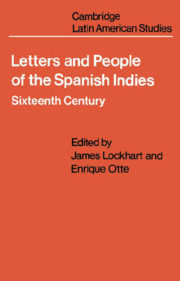Book contents
- Frontmatter
- Contents
- Preface
- Part I Conquest
- Part II The Variety of Life in the Indies
- 11 An encomendero's establishment
- 12 An encomendero's opinions
- 13 The miner
- 14 Commerce across the Atlantic
- 15 The professor of theology
- 16 The new arrival
- 17 The tanner and his wife
- 18 The troubadour
- 19 The nephew
- 20 The garden and the gate
- 21 The woman as settler
- 22 The farmer
- 23 The petty dealer
- 24 The Flemish tailors
- 25 The nobleman
- 26 The Hispanized Indian
- 27 Indian high society
- 28 An Indian town addresses the king
- Part III officials and Clerics
- Bibliography
- Index
23 - The petty dealer
from Part II - The Variety of Life in the Indies
Published online by Cambridge University Press: 06 August 2018
- Frontmatter
- Contents
- Preface
- Part I Conquest
- Part II The Variety of Life in the Indies
- 11 An encomendero's establishment
- 12 An encomendero's opinions
- 13 The miner
- 14 Commerce across the Atlantic
- 15 The professor of theology
- 16 The new arrival
- 17 The tanner and his wife
- 18 The troubadour
- 19 The nephew
- 20 The garden and the gate
- 21 The woman as settler
- 22 The farmer
- 23 The petty dealer
- 24 The Flemish tailors
- 25 The nobleman
- 26 The Hispanized Indian
- 27 Indian high society
- 28 An Indian town addresses the king
- Part III officials and Clerics
- Bibliography
- Index
Summary
Andres Garcia, in Mexico City, to his nephew Pedro Guinan in Colmenar Viejo, New Castile, 1571
… I deal in Campeche wood and cotton blankets and wax, and I also have a certain business in cacao …
The petty trader was first cousin of the petty agriculturalist. The activities of both were attractive to penniless newcomers because they could be undertaken without great capital or connections. Often called tratante or dealer, as distinct from the mercader, who was usually an import merchant, the small trader was rather lower on the scale than the small farmer. Ex-seamen, the lowest of the low, often became tratantes on land. Immigrants of foreign origin (especially Italians, for some reason) tended to gravitate to local small trade, whereas among the farmers the only non-Spaniards, in any numbers, were the nearly Spanish Portuguese. The tratantes dealt in anything that could be bought cheaply in the local economy and resold for silver. They were taverners, peddlers, traders of nags and used clothing. Their most characteristic operation was selling to the Indian population of the cities and mines, people who, if not as rich as the Spaniards, were able to pay money for the rapa de la tierra ('native cloth’), and other products of the traditional Indian economy which they still desired and which the dealers gladly supplied them at a profit.
Andres Garda is the very epitome of a tratante. We can surmise this good industrious man's social status among Spaniards by the fact that he is great friends with a mulatto woman, and married to an Indian. His trade is exclusively in Indian products, sold at the ticmguiz of San Juan in the southwest district of Mexico City, the most important Indian market in the city proper. (Tianquiztli, Nahuatl for ‘market,’ was picked up by the Spaniards and applied to Indian markets specifically; in this sense the word was even carried to other parts of the Indies.) The products Garcia sells are Indian, but not from the region of the capital. They come a long distance, from the southern lowlands of Yucatan, Chiapas and the Guatemalan coast of Soconusco. (When Garcia says he has a cacao business ‘in Soconusco,' he means he is involved in production or buying there; the cacao would be sold in Mexico City.) Trade in these products between highland and lowland long antedates the conquest, of course.
- Type
- Chapter
- Information
- Letters and People of the Spanish IndiesSixteenth Century, pp. 143 - 146Publisher: Cambridge University PressPrint publication year: 1976



